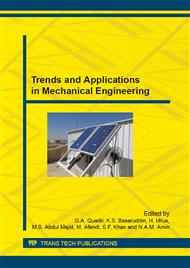p.340
p.345
p.349
p.354
p.361
p.367
p.372
p.378
p.383
FSI Analysis of the Effect of Aspect Ratio of Stacked Chip in Encapsulation Process of Moulded Underfill Packaging
Abstract:
Finite volume method (FVM) based simulation of 3D fluid-structure interaction (FSI) of stacked chip package during the encapsulation process of moulded underfill (MUF) in different aspect ratio is presented in this paper. The 3D model of flip chip package is built and meshed using ANSYS ICEM, and simulated by FLUENT software. Castro–Macosko viscosity model and volume of fluid (VOF) technique are applied for flow front tracking of the encapsulant. Curing kinetics is taken into consideration in the simulation using Kamal’s equation. To solve the Castro–Macosko and Kamal models, suitable user defined functions (UDFs) are developed using MS VISUAL STUDIO.NET software and incorporated into the FLUENT. The parameter such as different aspect ratio of stacked die of mold cavity on the flow front behaviour is mainly studied. Mechanical stresses experienced by the silicon die will also be monitored for risk of die cracking. The visualisation of the 3D stacking-chip package encapsulation process was presented at different filling times. The encapsulation model aided a clear visualisation and improved fundamental understanding of the design of a 3D integrated circuit encapsulation. The proposed analysis is expected to be a reference and guide in the design and improvement of 3D integration packages.
Info:
Periodical:
Pages:
361-366
Citation:
Online since:
August 2015
Keywords:
Price:
Сopyright:
© 2015 Trans Tech Publications Ltd. All Rights Reserved
Share:
Citation:


